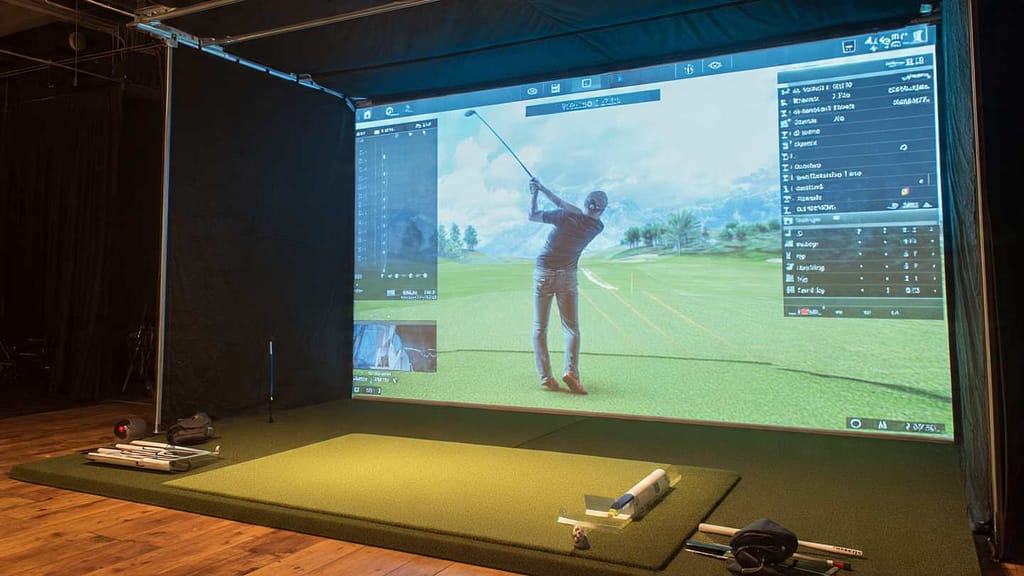Let Golf Simulators and Indoor Training Aids Improve Your Game

Whether you’re chasing your first birdie or trying to break 80, indoor golf training is no longer just a winter fallback. It’s a game-changer. With today’s advanced golf simulators and training aids, you can sharpen your swing, understand your data, and build a smarter strategy from the comfort of your home or local facility.
Let’s dive into how to use golf simulators and indoor training aids to improve your game, with 10 actionable tips that’ll help you play smarter and score lower.
10 Ways to Improve Your Game Indoors
- Start with a Dynamic Warmup Before you swing, activate your body. Use resistance bands, foam rollers, or simple stretches to loosen hips, shoulders, and spine. A 5-minute warmup improves swing speed and reduces injury risk.
- Use Simulators to Track Club Distance Most simulators measure carry distance, total distance, ball speed, and launch angle. Record your averages for each club to build a reliable yardage chart. This helps eliminate guesswork on the course.
- Practice Target-Based Drills Set up virtual flags or landing zones and challenge yourself to hit specific targets. This builds precision and simulates real on-course decision-making.
- Refine Your Swing Path with Visual Aids Use alignment sticks, swing mirrors, or laser guides to check your setup and swing plane. These tools help correct slices, hooks, and inconsistent contact.
- Analyze Ball Flight Data Pay attention to spin rate, launch angle, and shot dispersion. These metrics show whether your swing is producing optimal flight and where you’re losing distance or control.
- Work on Tempo and Rhythm Use metronome apps or tempo trainers to smooth out your backswing and transition. A consistent tempo leads to better timing and more solid contact.
- Simulate Real Rounds Play full virtual rounds on famous courses. This builds course management skills and helps you practice shot selection under pressure.
- Use Putting Mats and Gates Don’t neglect the flat stick! Use indoor putting mats with alignment guides or gates to improve aim, speed control, and stroke consistency.
- Record Your Swing Use your phone or simulator’s built-in camera to film your swing. Compare it to pro models or past sessions to track progress and spot flaws.
- Review Your Data with Golf Course Intel After your session, upload your stats to Golf Course Intel. Our AI helps you interpret the numbers and build a personalized strategy for any course in the world.
Understanding Your Data: What Matters Most
Golf simulators generate a ton of data, but which numbers should you focus on?


- Ball Speed: Directly affects distance. Higher speed = longer shots.
- Launch Angle: Ideal launch varies by club. Too low or too high reduces carry.
- Spin Rate: Impacts control and stopping power. Excessive spin can cause ballooning.
- Club Path & Face Angle: Determines shot shape (draw, fade, slice, etc.).
- Smash Factor: Efficiency of energy transfer. Higher = better contact. A perfect Smash Factor = 1.50.
Use this data to identify patterns. Are you consistently missing left? Is your driver spin too high? These insights guide your practice and equipment choices.
Why Golf Course Intel Is Your Secret Weapon

Golf Course Intel isn’t just another stat tracker, it’s your personal golf strategist. By analyzing your simulator data, we help you:
- Build a course-specific game plan
- Choose smarter targets and clubs
- Avoid trouble zones based on your tendencies
Check out our articles on why Golf Course Intel is a prime resource for turning raw data into real results. It’s the missing link between practice and performance.
Indoor golf training isn’t just convenient, it’s powerful. With the right tools, drills, and data insights, you can build a swing that holds up under pressure and a strategy that wins rounds.
So grab your clubs, fire up the simulator, and start training like a pro. Your best golf is just a swing away.




0 Comments